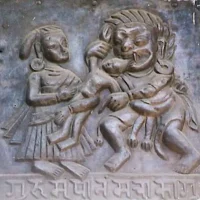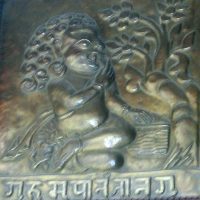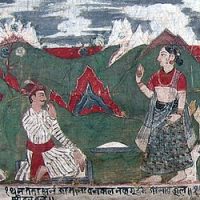Gurumapa : The Child Eater
Listen
At a glance
| Description | |
|---|---|
| Origin | Nepali Mythology |
| Classification | Hybrids |
| Family Members | N/A |
| Region | Nepal |
| Associated With | Child Eating, Size, Strength |
Gurumpa
Introduction
Gurumpa, also known as Gurumapa, is one of the most haunting figures in Newar mythology, deeply rooted in the folklore of the Kathmandu Valley. This terrifying giant from the Nepal Mandala region embodies fear, morality, and tradition, serving as both a mythical being and a cultural lesson for generations of Newar families. His story, passed down orally through centuries, revolves around his insatiable appetite for disobedient children and the uneasy truce between man and monster that still echoes in annual rituals. Unlike divine deities or benevolent spirits, Gurumpa’s legend speaks of primal fear and human cunning—a tale that captures the heart of Newar oral heritage and the values embedded in community discipline and ritual appeasement.
Physical Traits
Gurumpa is described as a monstrous giant whose terrifying appearance alone could silence even the most defiant child. He is said to have enormous limbs, a broad, grotesque face, and huge protruding fangs that gleam in the dark. His skin is often imagined as dark and coarse, symbolizing decay and danger lurking in the unseen corners of Kathmandu. The eyes of Gurumpa, glowing with a predatory hunger, add to his ghastly persona, and his immense size suggests that he could crush houses and devour humans effortlessly. Traditional depictions portray him crouched low, with tangled hair, gnarled nails, and a menacing grin—an image carefully crafted to inspire awe and terror. His monstrous features symbolize both the wrath of nature and the moral boundaries that children were expected to respect within the household and community.
Family
Unlike many mythological beings who descend from gods or belong to celestial lineages, Gurumpa exists outside the divine order. He has no known parents, siblings, or offspring, representing a force of raw, untamed nature rather than divine will. His only significant connection in folklore is with Kesh Chandra, a gambler from Itum Bahal in Kathmandu. Their story forms the foundation of Gurumpa’s myth—an allegory about greed, desperation, and the human capacity to manipulate even monstrous forces. When Kesh Chandra’s gambling led to his ruin, he encountered Gurumpa in the forest and struck a dangerous bargain: in exchange for food and respect, the giant would be appeased and allowed to coexist peacefully with the townspeople. Thus, while Gurumpa lacks a biological family, his bond with Kesh Chandra and the Newar community makes him part of Kathmandu’s moral and ritual “family,” a reminder that even chaos can be controlled through cunning and communal cooperation.
Other names
The name Gurumpa is often interchanged with Gurumapa or Gurumāpā, depending on the dialect and transliteration from Nepal Bhasa or Devanagari. In Newar language, he is referred to as 𑐐𑐸𑐬𑐸𑐩𑐵𑐥𑐵, pronounced similarly to “Gurumapa.” The term itself does not have a definitive translation, but the phonetic combination evokes a sense of authority and dread—“Guru” often meaning master or great, and “Mapa” resembling father or caretaker. Ironically, this “great father” figure became synonymous with a man-eating monster who instills discipline through terror. While different spellings exist across manuscripts and oral traditions, the being they describe remains the same—Kathmandu’s most feared yet respected mythical creature.
Powers and Abilities
Gurumpa’s strength lies not only in his physical power but in the psychological hold he has over the people. He possesses immense strength and is said to move through forests and fields with thunderous steps that shake the ground. His most infamous ability, however, is his capacity to appear out of nowhere to seize disobedient children. Parents in the Kathmandu Valley traditionally invoked his name as a warning—“Behave, or Gurumpa will come for you!”—a phrase that carried real terror in the minds of young listeners. While his hunger for flesh defines his monstrous nature, Gurumpa also demonstrates intelligence and a strange sense of fairness. In the legend, he agrees to live away from human settlements in exchange for an annual offering of rice and buffalo meat. This ability to negotiate and honor his word transforms Gurumpa from a simple monster into a morally complex being—both feared and respected. He represents a delicate balance between chaos and order, power and appeasement, much like other guardian spirits found in Himalayan traditions.
Modern Day Influence
Even in modern Kathmandu, Gurumpa remains a vivid presence in the cultural imagination. The annual ritual at Tundikhel stands as a living tradition, blending folklore with urban identity. On the night of Holi, the offering of rice and buffalo meat is made to ensure the giant remains appeased—a symbolic act that keeps the myth alive while fostering cultural unity among the Newar people. Gurumpa’s image is depicted in murals, traditional masks, and street art, representing both ancestral fear and folklore preservation. He also features in Nepali literature, theatrical plays, and educational storytelling sessions designed to pass down moral lessons about greed, disobedience, and the power of community agreements. In contemporary interpretations, Gurumpa is no longer seen purely as a monster but as a reflection of societal balance—how humans coexist with the forces they cannot control, through ritual, respect, and remembrance.
The story of Gurumpa continues to thrive in Kathmandu’s living heritage, reminding each generation of the moral weight carried by myth. His legend endures as both a tool of discipline and a bridge between the ancient world of oral tradition and the modern city that still honors his name.
Related Images
Source
Bajracharya, J. (2024). The tale of Gurumapa. Retrieved from https://bajracharya.org/the-tale-of-gurumapa/
Gurumapa. (2024, March 9). In Wikipedia. Retrieved from https://en.wikipedia.org/wiki/Gurumapa
Newar Cultural Heritage Group. (2025, June 11). GURUMAPA: The darkest folklore of Nepal [Video]. YouTube. https://www.youtube.com/watch?v=TcWkbczY-3I
Yomari Cartoon Series. (n.d.). Gurumapa is a famous mythical creature among Newars [Facebook post]. https://www.facebook.com/yomariCartoonSeries/posts/gurumapa-is-a-famous-mythical-creature-among-newars-who-resided-in-itum-bahal-ac/476918450321507/
Sonpal Samaj UK. (1999). Dr. Om Gurung- The Gurungs of Nepal. https://www.uksonpalsamaj.com/article/dr-om-gurung-the-gurungs-of-nepal/
Wikipedia. (2018, September 6). Category: Nepalese legendary creatures. https://en.wikipedia.org/wiki/Category:Nepalese_legendary_creatures
Literary Nepal. (2022). Literary studies journal. https://literarynepal.org.np/wp-content/uploads/2022/03/Literary-Studies-Journal_Final.pdf
Shrestha, B. (2010). Newar Folktales and Legends. Kathmandu: Mandala Publications.
Tuladhar, P. (2015). Myths and Monsters of Kathmandu. Nepal Heritage Press.
Allen, M. (1998). Ritual and Narrative in the Kathmandu Valley. Himal Books.
Gellner, D. N. (1997). Newar Society and Culture. Cambridge University Press.
Frequently Asked Questions
What is lorem Ipsum?
I am text block. Click edit button to change this text. Lorem ipsum dolor sit amet, consectetur adipiscing elit. Ut elit tellus, luctus nec ullamcorper mattis, pulvinar dapibus leo.
What is lorem Ipsum?
I am text block. Click edit button to change this text. Lorem ipsum dolor sit amet, consectetur adipiscing elit. Ut elit tellus, luctus nec ullamcorper mattis, pulvinar dapibus leo.
What is lorem Ipsum?
I am text block. Click edit button to change this text. Lorem ipsum dolor sit amet, consectetur adipiscing elit. Ut elit tellus, luctus nec ullamcorper mattis, pulvinar dapibus leo.
What is lorem Ipsum?
I am text block. Click edit button to change this text. Lorem ipsum dolor sit amet, consectetur adipiscing elit. Ut elit tellus, luctus nec ullamcorper mattis, pulvinar dapibus leo.
What is lorem Ipsum?
I am text block. Click edit button to change this text. Lorem ipsum dolor sit amet, consectetur adipiscing elit. Ut elit tellus, luctus nec ullamcorper mattis, pulvinar dapibus leo.








